Dinorwic quarry
The Dinorwic quarry (/dɪˈnɔːrwɪɡ/; Welsh: [dɪˈnɔrwɪɡ]; also known as Dinorwig quarry) is a large former slate quarry, now home to the Welsh National Slate Museum, located between the villages of Llanberis and Dinorwig in North Wales. It was the second largest slate quarry in Wales, indeed in the world, after the neighbouring Penrhyn quarry near Bethesda.[1]
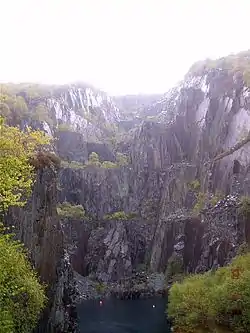 Vivian quarry, part of the Dinorwic quarry | |
| Location | |
|---|---|
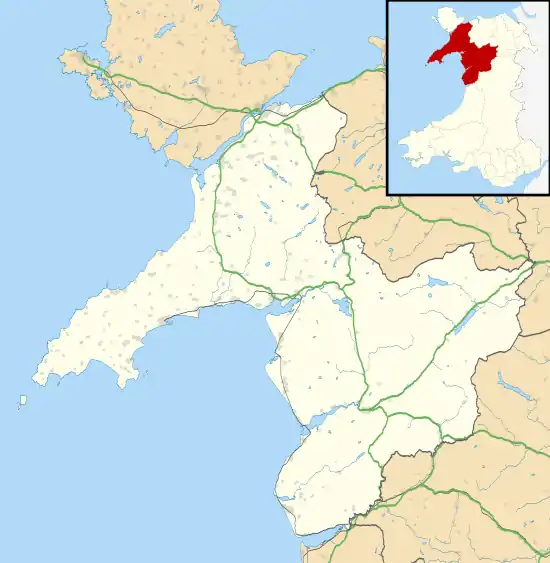 Dinorwic Location in Gwynedd | |
| Location | Dinorwig, near Llanberis |
| County | Merioneth (now Gwynedd) |
| Country | Wales, UK |
| Coordinates | 53°07′34″N 4°05′53″W SH 59631 60860 |
| Production | |
| Products | Slate |
| Type | Quarry |
| History | |
| Opened | 1787 |
| Closed | July 1969 |
It covered more than 700 acres (283 ha) consisting of two main quarry sections with 20 galleries in each and a number of ancillary workings. Extensive internal tramway systems connected the quarries using inclines to transport slate between galleries.[2]
History
The first commercial attempts at slate mining took place in 1787, when a private partnership obtained a lease from the landowner, Assheton Smith. Although this met with moderate success, the outbreak of war with France, taxes and transportation costs limited the development of the quarry. A new business partnership led by Assheton Smith was formed on the expiry of the lease in 1809 and the business boomed after the construction of a horse-drawn tramway to Port Dinorwic in 1824. At its peak in the late 19th century, "when it was producing an annual outcome of 100,000 tonnes", Dinorwic employed more than 3,000 men and was the second largest opencast slate producer in the country. Although by 1930 its working employment had dropped to 2,000, it continued in production until 1969.
Slate removal & quarry development
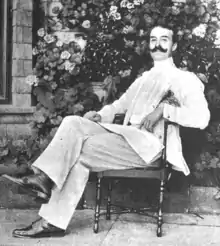
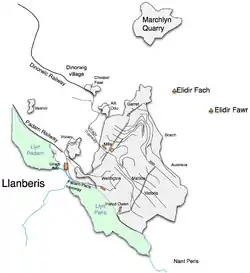
The slate vein at Dinorwic is nearly vertical and lies at or near the surface of the mountain, allowing it to be worked in a series of stepped galleries . This is however not quite how the quarry developed.
The first quarrying was spread across several sites: Adelaide, Allt Ddu, Braich, Bryn Glas, Bryn Llys, Chwarel Fawr, Ellis, Garrett, Harriet, Matilda, Morgan's, Raven Rock, Sofia, Turner, Victoria and Wellington.[3] This was a situation that lasted for many years, certainly until the mid-1830s.
The 1824 railway brought transport problems. Produce from the upper quarries was not a problem, but Wellington, Ellis, Turner, Harriet and Victoria quarries were all below the level of the railway. This was a problem solved in the 1840s when the lake level railway was built, and the quarry as we know it began to take shape.
Adelaide quarry became a part of Allt Ddu, and Chwarel Fawr and Chwarel Goch became linked to it too. In the 'Great New Quarry' Raven Rock and Garret Quarries became one massive quarry, operating as an open hillside gallery quarry, with the lowest two levels being accessed by tunnels. Harriet, Morgans and Sofia quarry are all still identifiable as separate pits today, whilst Braich quarry became a large working of three contiguous smaller pits. Below this, The galleries of Victoria and Wellington were joined along the hillside, and continued downwards in two separate main workings: Wellington and Hafod Owen. Each was eventually to contain several small sinks too, some below lake level. The current form of the quarry is little different from that of the time of the Great War, save for enlarging of the actual quarry faces, and deepening of the sinks. Certainly all the main inclines were in place, very little was altered until closure.[4]
The nearby Marchlyn quarry was opened in the 1930s to provide access to the main slate vein higher up the mountain.
Closure
The quarry closed in July 1969, the result of industry decline and difficult slate removal.[2] During the 1950s/60s extraction had become difficult, because after 170 years of extraction many of the unsystematically dumped tips were beginning to slide into some of the major pit workings, and after an enormous fall in the Garret area of the quarry in 1966, production had ceased almost permanently. It was however decided that some final work could be done by clearing some of the waste from the Garret fall. This involved making an access road for more modern quarry vehicles across some of the terraces, to the rock fall. This amount of slate won by this method was small and all production stopped by 1969.
At the Receiver's instruction a public auction was arranged, intended to pay off some of the quarry's debts. The auctions were held on 12 and 13 December 1969. The auctioneer's national advertisement (in The Guardian 29 November 1969), the event was described as "An auction sale of machine tools and stocks, four Hunslet locos, and engine and boat fittings". The locomotives referred to, lots 613–616, were "Dolbadarn", "Red Damsel", "Wild Aster" and "Irish Mail". Before the bidding started, it was announced that Gwynedd County Council had placed a Preservation Order on the Gilfach Ddu workshops, and many items within it.
Transport
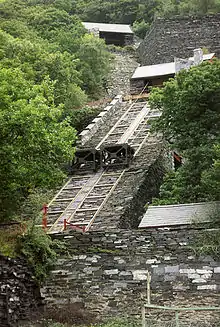
Llanberis Lake Railway | |||||||||||||||||||||||||||||||||||||||||||||||||||||||||||||||||||||||||||||||||||||||||||||||||||||||||||||||||||||||
|---|---|---|---|---|---|---|---|---|---|---|---|---|---|---|---|---|---|---|---|---|---|---|---|---|---|---|---|---|---|---|---|---|---|---|---|---|---|---|---|---|---|---|---|---|---|---|---|---|---|---|---|---|---|---|---|---|---|---|---|---|---|---|---|---|---|---|---|---|---|---|---|---|---|---|---|---|---|---|---|---|---|---|---|---|---|---|---|---|---|---|---|---|---|---|---|---|---|---|---|---|---|---|---|---|---|---|---|---|---|---|---|---|---|---|---|---|---|---|---|
| |||||||||||||||||||||||||||||||||||||||||||||||||||||||||||||||||||||||||||||||||||||||||||||||||||||||||||||||||||||||
The original connection between the quarry and the company's port at Y Felinheli was the Dinorwic Railway, a 2 ft (610 mm) gauge line built in 1824. This was worked by horses and it soon became apparent that it was inadequate for the traffic generated by the quarry. A number of surveys of alternative routes were undertaken by members of the Spooner family, the result of which was the construction of a new railway which opened in 1848: the 4 ft (1,219 mm) gauge Padarn Railway which operated as the quarry's main transport link until closure in 1961.[2]
Tramways
The first use of railways at the quarry came around 1800 when the first internal tramways were in use. These first lines were worked using horse- and hand- power. For the next seventy years the tramway system grew until it reached the point where more powerful traction was required. The first steam locomotives used were small vertical boilered locos supplied by De Winton's of Caernarfon. In 1870 the first locomotive supplied by the Hunslet Engine Company arrived at the quarry, and the majority of the locomotives that worked at Dinorwic were eventually supplied by Hunslet.[2]
Between 1935 and 1949 the Quarry acquired 22 light internal combustion rail tractors for use on the levels. Half of these were new, the other half second-hand. Their survival rate did not match those of the steam locomotives, and when the quarry closed in 1969 only three still survived.
Although a nominal two-foot gauge, the actual gauge between the rails at Dinorwic was 1 ft 10 3⁄4 in (578 mm)[5] in common with its neighbour Penrhyn, but fractionally narrower than the public lines of the Ffestiniog Railway or North Wales Narrow Gauge Railway which were 1 ft 11 1⁄2 in (597 mm).
Locomotives
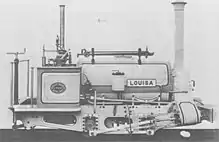
Early steam locomotives used by the quarry, and built by De Winton & Co. But from 1870 the quarry acquired most of its locomotives new from the Hunslet Engine Company of Leeds. These were purpose built, initially using a series of Hunslet general/unclassified designs, but after 1886 these fell into one of three purpose built classes:
- Alice
- Port: larger and designed primarily to work at Port Dinorwic, although Michael never did.
- Tram or Mills: worked on marshalling duties on the Padarn–Peris Tram Line, which linked the quarry mills to the Padarn Railway for transportation to Port Dinorwic.
| Orig. name / number | Later name | Builder | Year of acquisition | Year of sale | Notes |
|---|---|---|---|---|---|
| Restoration project taking place at the West Lancashire Light Railway | |||||
| Alice class | |||||
| Alice class Preserved at the Statford Barn Railway | |||||
| Alice class | |||||
| Alice class Preserved at the NGM | |||||
| Alice class preserved at the Statfold Barn Railway | |||||
| Alice class | |||||
| Alice class | |||||
| Alice class | |||||
| Alice class | |||||
| Alice class | |||||
(briefly Covertcoat) |
Alice class | ||||
| Alice class preserved at West Lancashire Light Railway | |||||
| Alice class | |||||
| Port class | |||||
| Port class | |||||
| Port class Preserved at the Statford Barn Railway | |||||
| Tram/Mills class | |||||
| Tram/Mills class | |||||
After closure
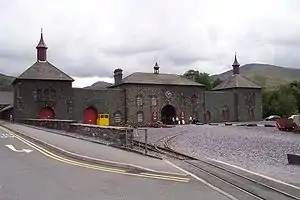
Following closure the quarry's workshop, at Gilfach Ddu was acquired by the then Caernarfonshire County Council, who now lease the building to the National Museum and Galleries of Wales. It now houses the National Slate Museum. Equipment from the internal quarry railway was used to build the Llanberis Lake Railway over part of the trackbed of the Padarn Railway.
The quarry has been partly reused as part of the Dinorwig power station, a pumped storage hydroelectric scheme.
Many of the Hunslet locomotives built to work in the quarry and at the port have been preserved on several of Britain's narrow gauge heritage railways. More recently, new build versions of the class have been built by the Exmoor Steam Railway, and by a new Hunslet company at the Statfold Barn Railway.
Part of the film Willow was shot in the disused Dinorwic quarry, in June 1987 on some of the lower terraces next to the Pumped storage scheme. Scenes from Street Fighter were filmed on the south side of "Watford Gap" near the Matilda hole. Clash of the Titans was filmed in the quarry in 2009.
Present
The quarries are now also used as an adventure rock climbing and scuba diving venue. The Blue Peris Mountain Centre, operated by Bedford Borough Council and Central Bedfordshire Council, conducts various outdoor activities at the quarries.
The Vivian quarry section has both climbing and diving sections. The diving experience has normally good visibility, with depths ranging from 6 metres (20 ft) to 18 metres (59 ft), a platform at 6 metres (20 ft), plus flooded buildings, boats, a van and a gnome garden.
References
- Jones, R. Merfyn. 1981. The North Wales quarrymen, 1874-1922, Studies in Welsh history 4. University of Wales Press; ISBN 0-7083-0776-0
- Carrington D.C. and Rushworth T.F. (1972). Slates to Velinheli: The Railways and Tramways of Dinorwic Slate Quarries, Llanberis and the Llanberis Lake Railway. Maid Marian Locomotive Fund.
- G.A.S. Vanol 4190
- Ordnance Survey Caernarvonshire 25" plan 1914
- "Industrial Railways – Dinorwic Quarries and Padarn Railway". Narrow Gauge Railway Museum.
Sources
- "Penmorfa article on Dinorwic".
- Narrow Gauge Railways in North Caernarvonshire: Volume 3. Boyd, James I.C. (1986). The Oakwood Press; ISBN 0-85361-328-1
